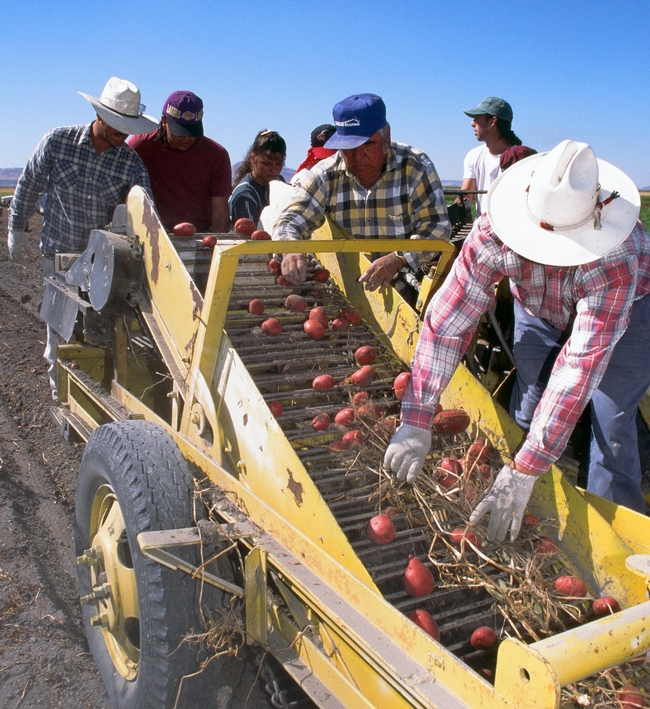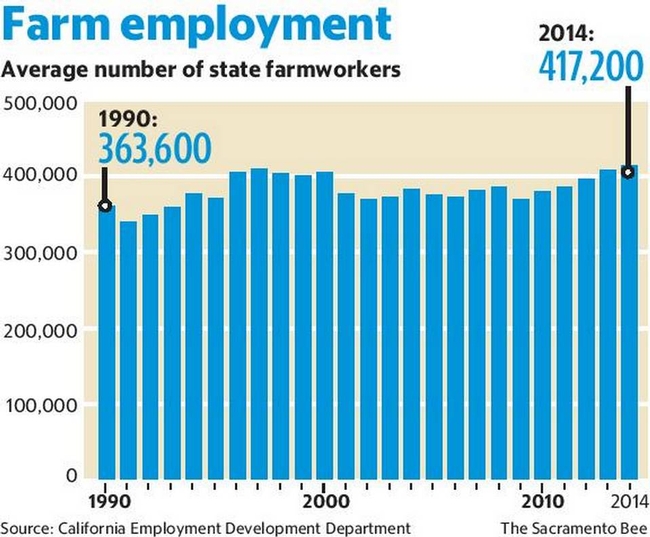
Despite the drought, the number of workers employed in California's agricultural industry rose to its highest level in at least 24 years, as many farmers shifted toward labor-intensive, permanent crops, according to the latest state and federal statistics.
The employment figures paint a more complicated picture than the message from some state officials and agricultural employers who publicly lament the drought's impact on farmworkers. For example, Gov. Jerry Brown last month told a national television audience that “farmworkers who are at the very low end of the economic scale here are out of work.”
The state's agricultural workforce would have grown faster last year if not for drought – but it still grew, several farm economists said.
“There's no doubt in the data that the impact of the drought … has been smaller than we expected, surprisingly so,” said Jeffrey Michael, director of the Center for Business and Policy Research at the University of the Pacific.
The effect of the drought on California agriculture and its workforce is a sensitive topic. Agriculture takes 80 percent of the water used by people in California, though its share falls to 40 percent of the state's supply when the water used for fish and other environmental purposes is taken into account.
Brown largely excluded farmers from an executive order mandating that urban customers reduce water consumption by 25 percent this year. But hundreds of farmers in the Central Valley have been told to expect no water deliveries from the federal government, and hundreds more have seen their water rights curtailed by the state.
Largely because of a lack of water, farmers last year fallowed roughly 500,000 acres, satellite photos and federal statistics indicate. That's equivalent to more than 5 percent of the state's irrigated cropland.
Most land fallowed was devoted to crops such as rice and wheat that do not require a high number of workers, Michael and other economists said. Meanwhile, fruit and berry production, which often requires more workers, increased.
Overall, there was more farm work available in California last year than during any other year at least since 1990, when modern record-keeping began, according to the state Employment Development Department. And hired farmworkers collectively made more money, too, separate federal data show.
California farms employed about 417,000 workers, on average, each month during 2014, up by 6,000 from 2013, state figures show. Farm employment increased by about 30,000 from 2004 to 2014.
- 417,000 Average number of California farmworkers last year
- 6,000 Growth in farmworkers from 2013 to 2014
- 30,000 Growth in farmworkers from 2004 to 2014
With average pay of roughly $9 per hour, front-line farm employees are among the lowest-paid workers in California. But hired farmworker wages and salaries rose 2 percent to $6.5 billion from 2013 to 2014, after adjusting for inflation, according to the U.S. Bureau of Economic Analysis.
Several labor economists said they were surprised by the trend. A widely cited UC Davis report released in July predicted that the drought would result in “17,100 jobs lost” in 2014.
Daniel Sumner, a UC Davis agricultural economist who co-authored the report, said, “I'm not going to stand by that number and say, ‘Gee we must have nailed it.' ”
But, he and others said, the state would have added thousands more farm jobs if not for the drought. Put another way, the farm labor market could have grown faster if more water were available. Had fallowed acres contained crops, workers would have been needed to sustain them.
“You cannot grow crops on half a million acres with no labor,” said Richard Howitt, a UC Davis agricultural economist and another report co-author.
Fields fallowed last year mostly had been used to grow wheat, rice, hay, corn and cotton, Michael said, citing USDA statistics. Acreage devoted to nuts, wine grapes and some vegetables increased.
“There's still a lot of labor-intensive crops … that are keeping people busy,” said Lupe Sandoval, managing director of the California Farm Labor Contractor Association. “We still have a lot of strawberries, we still have a lot of grapes. … The cherry harvest is just getting underway. That's three to four weeks of pretty intensive labor.”
Marc Grossman, spokesman for the United Farm Workers in California, said workers in his union have been in high demand during the drought. Most union workers toil in strawberry, wine grape and vegetable fields. “Union members have been working in the last few years more hours rather than less,” he said.
Employment patterns vary from place to place – and even from farm to farm – across California. The data “doesn't mean people didn't lose their jobs,” Sumner said.
Mike Daddow, a fourth-generation rice grower in southern Sutter County, is fallowing 150 of his 650 acres for the second year in a row. He employs six workers this year instead of the usual 10.
Three of his employees are part-timers, and normally “you really push the overtime,” and guys get a lot more hours, he said. Not last year, or this year. “The three part-time guys had shorter hours (last year) and, of course, no overtime.”
Several labor economists said they could not yet predict how the drought would effect employment during 2015. Farms employed about 5,000 fewer workers during the first three months of 2015 as compared to the same period of 2014, state figures show. Hiring tends to peak during the summer.
“I would hesitate to make the kind of predictions we did in the past, because clearly it didn't come true in 2014,” Michael said.
Source: Originally published on The Sacramento Bee as California farms added workers in 2014, even amid drought by Phillip Reese and Dale Kasler, May 19, 2015.
